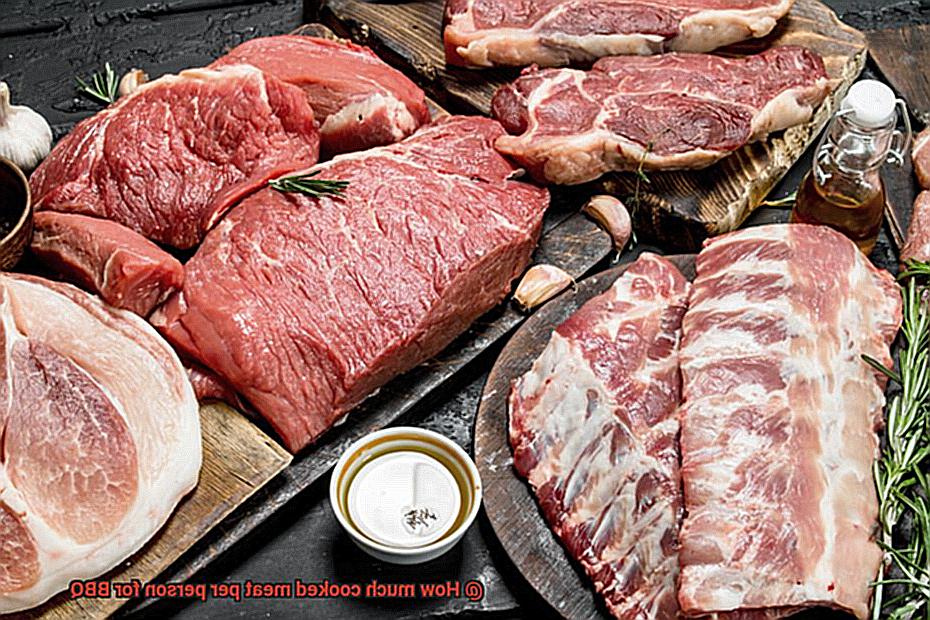Summertime is here, and that means it’s time to dust off the grill and start planning your next backyard BBQ. But before you start marinating your meats, there’s one question you need to answer: how much cooked meat per person for BBQ? Don’t worry, we’ve got you covered.
Whether you’re a seasoned pro or a first-time griller, figuring out how much food to prepare can be tricky. You don’t want to run out of food and leave your guests hungry, but you also don’t want to be stuck with a fridge full of leftovers. So, how do you find the sweet spot?
While there isn’t a one-size-fits-all answer, there are some general guidelines that can help you calculate the perfect amount of meat for your party. Factors like the type of meat, the size of your guest list, and other menu items can all play a role in determining how much food to cook up.
But fear not – we’re here to help. In this blog post, we’ll explore some tips and tricks for calculating the ideal amount of cooked meat per person for BBQ. From juicy burgers to succulent ribs, we’ll make sure no one leaves your party hungry.

So grab your tongs and let’s get started. Whether you’re hosting an intimate gathering or a big bash, we’ve got everything you need to know about serving up the perfect amount of mouth-watering meat at your next BBQ.
Contents
Considerations When Planning for Cooked Meat Per Person
Hosting a BBQ is a great way to enjoy the summer weather and spend time with loved ones. However, one of the most critical considerations when planning a successful BBQ is determining the right amount of cooked meat per person. You want to ensure that there’s enough food for everyone without having too many leftovers. Here are some factors to consider when planning for cooked meat per person at your next BBQ.
Firstly, it’s essential to think about the type of meat you plan to serve. Different cuts of meat have varying weights and yields after cooking. For instance, bone-in ribeye steak will weigh more before cooking than boneless chicken breasts. Additionally, fattier cuts of meat tend to shrink more when cooked than leaner cuts. Therefore, it’s crucial to consider the cut of meat you’ll be serving to determine the right amount of cooked meat per person.
Secondly, you need to consider the appetites of your guests. Will there be big eaters in attendance, or are they moderate eaters? Will there be other food options available, such as sides and desserts? Generally, adults consume around 6-8 ounces of cooked meat per meal. However, if you’re hosting a group of big eaters or serving mostly teenage boys, you might want to increase this amount.
Another crucial consideration is whether you’ll be serving meat as the main course or as part of a larger meal. If you plan to serve multiple courses or have many side dishes and appetizers, you might be able to serve less meat per person. Conversely, if meat is the star of the show and there won’t be many other food options available, you may need to increase the amount of meat per person.
Lastly, it’s vital to think about any dietary restrictions or preferences your guests might have. If you have vegetarians or vegans attending your BBQ, provide alternative protein sources for them. Also, if any of your guests have allergies or intolerances to certain meats, it’s crucial to avoid cross-contamination and ensure they have safe options to eat.
How Much Meat Per Person Varies by Type of Meat
First things first: it’s crucial to keep in mind that the amount of meat needed can vary significantly depending on the type of meat being served. Let’s start with beef. As a general rule of thumb, plan for around 6-8 ounces of cooked meat per person. However, bear in mind that this can fluctuate based on the cut you’re serving. For example, a heartier steak may require up to 12 ounces per person, while ground beef may only necessitate around 4-5 ounces per person.
Moving on to pork, aim for around 5-6 ounces of cooked meat per person. But again, this can vary depending on which cut you choose. If you’re serving ribs, expect your guests to consume more meat per person than if you’re dishing out pork chops.
When it comes to chicken, plan for around 4-5 ounces of cooked meat per person. However, don’t forget that this estimate can vary depending on the cut as well. Chicken wings, for instance, may require more meat per person than chicken breasts.
Lastly, let’s talk about fish and seafood. Plan for around 6-8 ounces of cooked meat per person, but keep in mind that this can vary depending on which type of fish or seafood you’re serving. Shrimp, for example, may require more meat per person than salmon.
It’s essential to remember that these are just guidelines; individual appetites can and will vary. Therefore, it’s always better to have too much food than not enough. Consider cooking extra if you’re unsure about the amount needed. Additionally, keep in mind any dietary restrictions or preferences your guests may have.
Factors to Consider When Serving Additional Sides
When planning a barbecue, it’s important to remember that the sides are just as important as the main course. To make sure your guests leave satisfied, consider the following factors when preparing additional sides.
Firstly, guest count is crucial. It’s better to overestimate than underestimate the amount of food needed. Make sure you prepare enough to feed everyone, with some extras for those who may want seconds.
Secondly, think about the type of sides you’ll serve. Heavier options like mac and cheese and potato salad typically require smaller portions per person. Lighter options like fresh salads and grilled vegetables can be served in larger quantities. Consider the balance of the meal and adjust portion sizes accordingly.
Thirdly, take into account any dietary restrictions or preferences your guests may have. Providing vegetarian options like veggie burgers or grilled portobello mushrooms is thoughtful for vegetarian guests. Labeling dishes for those with allergies or intolerances is always appreciated.
Lastly, consider the length of time your guests will be at the barbecue. If it’s an all-day event, provide smaller snacks or dishes throughout the day to keep everyone fueled and satisfied. You don’t want anyone getting cranky from hunger.
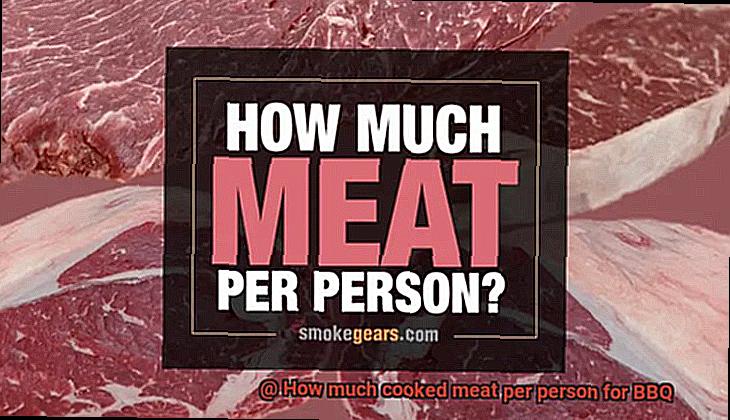
Dietary Restrictions and Preferences to Keep in Mind
Summer is synonymous with backyard barbecues, but as a responsible host, you need to be mindful of your guests’ dietary restrictions and preferences. From allergies to religious beliefs to personal choices, it’s essential to consider these factors before you plan your menu. As an expert in this topic, I’m here to share some tips on how to make sure everyone feels welcome and included.
First and foremost, allergies are a serious matter. It’s crucial to ensure that your guests who have food allergies can enjoy the food you’re serving without any risk of cross-contamination. To achieve this, use separate cooking surfaces and utensils for different types of meat. For example, someone with a shellfish allergy could be at risk if shrimp is cooked on the same surface as other meats. By being extra cautious, you can avoid any potential allergic reactions and make everyone feel safe.
Secondly, religious restrictions should also be taken into account. Different religions have varying dietary laws, so it’s essential to research what applies to your guests’ beliefs. For instance, if someone follows a Kosher or Halal diet, they may only eat meat that has been prepared in specific ways. By catering to these restrictions, you demonstrate your respect for their beliefs and create a welcoming environment for everyone.
Lastly, personal dietary preferences should not be overlooked. With more people adopting vegetarian or vegan diets, it’s vital to offer options that suit their lifestyle choices. Grilled vegetables, tofu, and veggie burgers are fantastic alternatives that will satisfy even the most ardent meat-eaters. Ensure that you label these options correctly and cook them separately from the meat to prevent cross-contamination.
Calculating the Amount of Cooked Meat Needed for a BBQ
But before you start firing up the grill, it’s crucial to calculate the amount of cooked meat needed to ensure that all your guests are satisfied and full.
The first thing to consider is the number of people attending your BBQ. Once you’ve got that number, you can start thinking about the type of meat you want to serve. Different meats have different serving sizes, so it’s essential to keep that in mind when making your calculations.
For beef, a good rule of thumb is to estimate 6 to 8 ounces per person. Chicken can be estimated at 4 to 6 ounces per person, while pork should be estimated at around 5 to 7 ounces per person. Remember that these serving sizes can be adjusted based on whether or not there will be additional sides and appetizers available.
It’s also important to consider any dietary restrictions or preferences of your guests. If there are vegetarians or vegans attending your BBQ, make sure to provide alternative options like grilled veggies or tofu burgers. And if any of your guests have food allergies or intolerances, make sure you have options available that cater to their needs.
When calculating the amount of cooked meat needed for a BBQ, some basic math skills come in handy. To determine the total amount of meat needed, simply multiply the estimated serving size by the number of guests attending. For instance, if you plan on serving beef with an estimated serving size of 6 ounces per person and expect 20 guests, you will need a total of 120 ounces or 7.5 pounds of beef.
To summarize, here are some key points to remember:
- Consider the number of guests attending your BBQ
- Think about the type of meat you want to serve and estimate its serving size
- Take into account any dietary restrictions or preferences of your guests
- Use basic math skills to calculate the total amount of meat needed
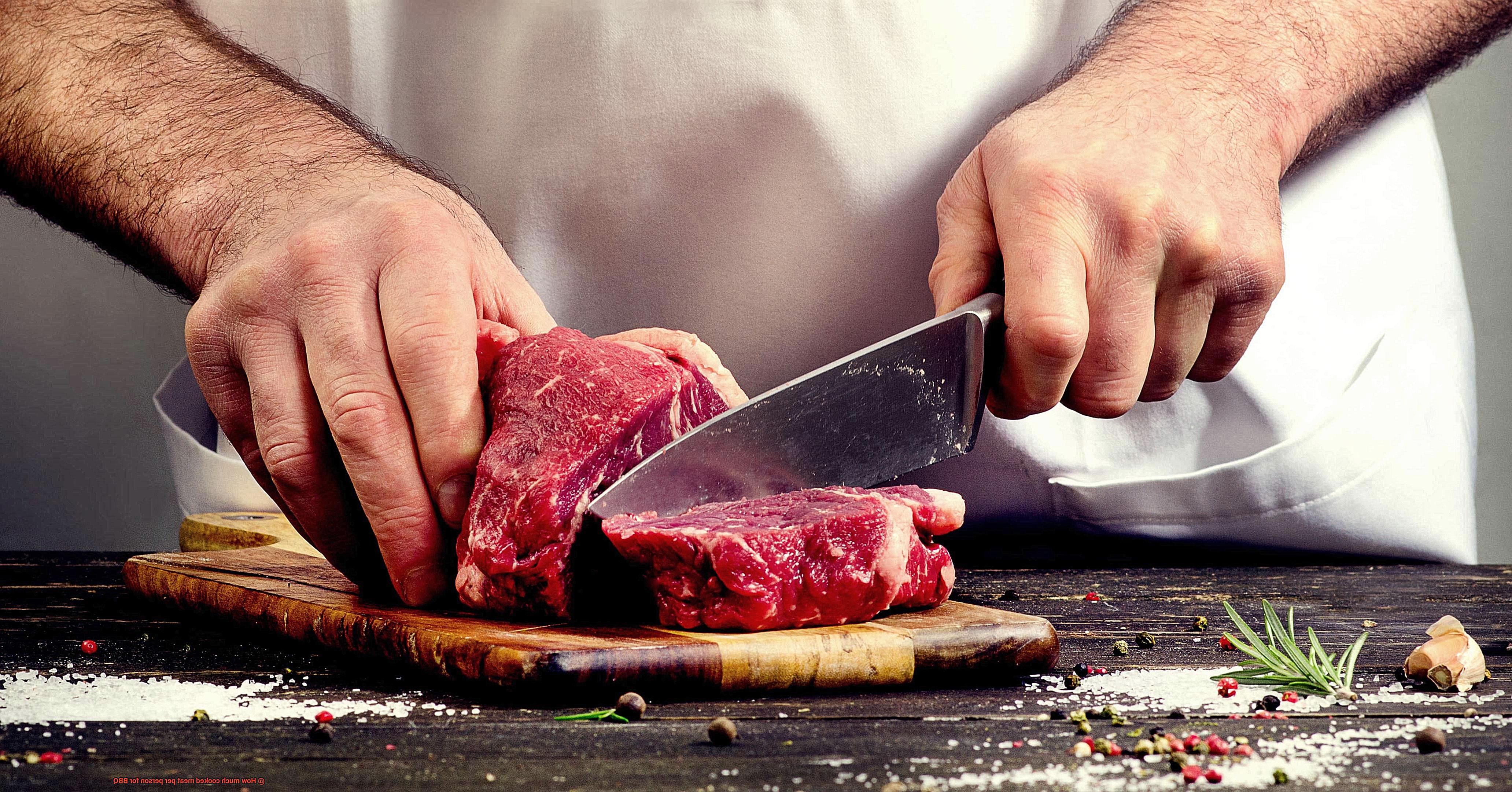
Tips for Minimizing Waste When Calculating Cooked Meat Portions
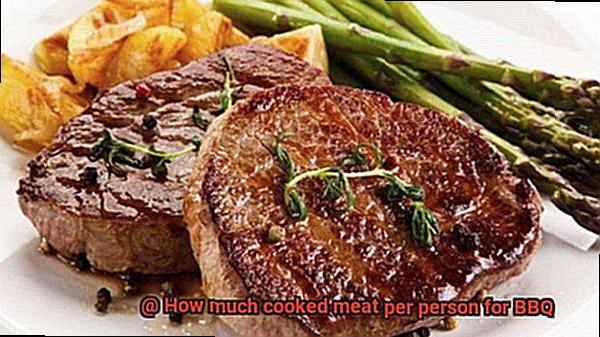
Organizing a BBQ is an enjoyable activity, but it can be challenging to calculate how much food you need to feed your guests without wasting any. Here are five tips for minimizing waste when calculating cooked meat portions for your BBQ:
Utilize a Meat Calculator
To plan your BBQ correctly, use a meat calculator that considers the number of guests and their preferences. A meat calculator also factors in the type of meat, cooking method, and serving size.
Consider the Type of Meat
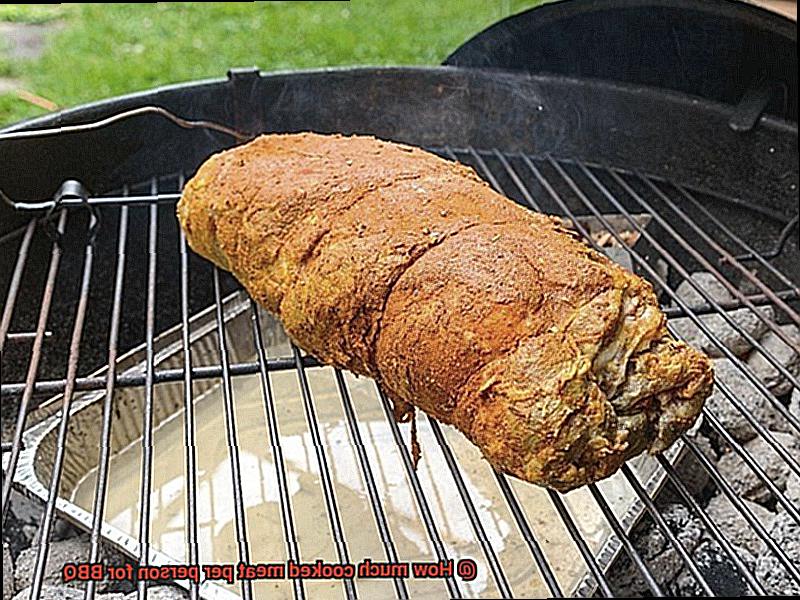
Different types of meats have varying shrinkage rates and cooking times that impact how much meat is necessary per person. For instance, brisket has a high shrinkage rate and may require more meat per person than chicken.
Don’t Forget About Sides
While calculating meat portions, remember to consider the number and size of side dishes being served. If there are many sides available, guests may not consume as much meat, leading to waste.
Plan for Leftovers
Plan for extra servings by estimating leftovers that can be used for sandwiches or added to other dishes. However, avoid overestimating too much as excess leftovers can also lead to waste.
Use Smaller Plates and Utensils
Serve your guests with smaller plates and utensils to encourage them to take smaller portions initially. This helps prevent overconsumption and minimize waste.
How to Store Leftover Cooked Meat from a BBQ
How to Properly Store Leftover Cooked Meat from a BBQ
After a fun-filled barbecue, you may find yourself with an abundance of leftover cooked meat. To ensure that the meat stays fresh and safe to eat, it’s crucial to store it properly. Here are five sub-sections that will guide you on how to store leftover cooked meat from a BBQ.
Cool it Down
The first step in storing leftover cooked meat is to let it cool down to room temperature before storing it. This will prevent bacteria growth and spoilage. Once cooled, place the meat in an airtight container or wrap it tightly with plastic wrap or aluminum foil.
Refrigerate or Freeze
It’s recommended to store the leftover cooked meat in the refrigerator for up to four days or in the freezer for up to three months. When storing in the fridge, use airtight containers or wrap the meat in plastic wrap or foil to prevent air from getting in and causing freezer burn. Consume the leftover meat within 3-4 days to ensure it’s still fresh. If you want to store the meat for longer than that, consider freezing it.
Label and Date
It is essential to label and date the containers of leftover cooked meat to keep track of their storage time. This will help prevent consuming spoiled or unsafe food and ensure maximum freshness and flavor. It’s best to label them with the date they were stored.
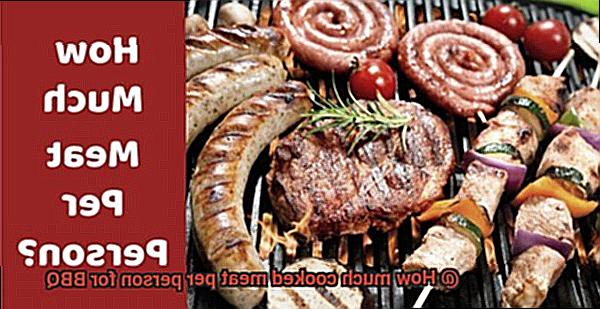
Reheat Properly
When reheating leftover cooked meat, make sure it reaches an internal temperature of at least 165°F (74°C) to kill any potential bacteria that may have grown during storage. Avoid reheating the same meat more than once as this can increase the risk of bacteria growth.
Consider Dietary Restrictions
Lastly, consider any dietary restrictions or preferences your guests may have. If you have vegetarian or vegan guests attending your barbecue, for example, you may want to serve less meat overall and provide additional vegetarian options.
Best Practices for Reheating Cooked Meats from a BBQ
The mouth-watering aroma of cooked meats from a BBQ lingers long after the party is over. But what about those delicious leftovers? Reheating cooked meats from a BBQ can be a bit daunting, but with the right practices, it can be done safely and effectively.
First and foremost, temperature control is essential. To ensure that any harmful bacteria are killed off, the internal temperature of your leftover meat should reach 165°F (74°C). You can use an oven, grill or microwave to reheat your meat, but make sure to check the temperature using a meat thermometer, especially if you’re dealing with thicker cuts of meat.
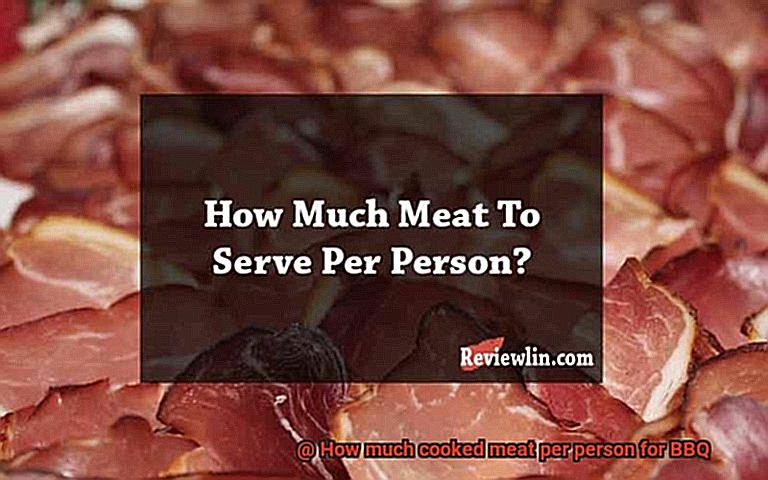
Even heating is also crucial to avoid dry, overcooked or undercooked meat that could make you sick. Slicing your meat into smaller portions before reheating helps ensure that each portion is heated evenly.
Proper storage is equally important since leftover meats should be refrigerated within two hours of cooking to prevent harmful bacteria growth. If left out for longer than two hours, it’s best to discard them.
Reheating cooked meats in small batches is recommended rather than all at once. This helps ensure that each portion is heated evenly and reduces the risk of foodborne illness. Adding a small amount of liquid, such as water or broth, to the container when reheating can also help prevent your meat from drying out.
9HBqJPGtdVk” >
Conclusion
In conclusion, hosting a BBQ is the perfect way to bask in the sun and spend quality time with your loved ones. However, it’s essential to plan out how much cooked meat per person you’ll need to avoid any hangry guests. Various factors such as the type of meat, size of your guest list, and other menu items can all impact how much food you should prepare. It’s also crucial to consider dietary restrictions or preferences your guests may have when planning your menu. By catering to these restrictions, you create an inclusive environment where everyone feels welcome.
To ensure that you have enough cooked meat for your BBQ, using a meat calculator that considers the number of guests and their preferences can be helpful. Different types of meats have varying shrinkage rates and cooking times that can affect how much meat is necessary per person. Lastly, storing leftover cooked meats from a BBQ should be done correctly to preserve maximum freshness and flavor. Reheating cooked meats from a BBQ should also follow best practices to avoid dry or undercooked meat that could make you sick.
By following these tips and tricks for calculating the ideal amount of cooked meat per person for BBQ, you’ll be able to host a successful event without any mishaps.

